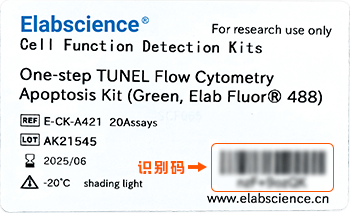Recombinant Human CD36 Protein(Fc Tag)

Price:
- 表达系统: Mammalian
- 蛋白编码: P16671
| 别称 |
Adipocyte membrane protein;BDPLT10;CD36;CD36 antigen (collagen type I receptor;thrombospondin receptor);CD36 antigen;CD36 molecule (thrombospondin receptor);CD36 molecule;CD36;CHDS7;Cluster determinant 36;Collagen receptor;platelet;FAT;Fatty acid translocase;Fatty acid transport protein;Glycoprotein IIIb;GP IIIb;GP3B;GP4;GPIIIB;GPIV;Leukocyte differentiation antigen CD36;MGC108510;MGC91634;PAS 4 protein;PAS IV;PAS-4;PASIV;Platelet collagen receptor;Platelet glycoprotein 4;Platelet glycoprotein IV;scarb3;Scavenger receptor class B member 3;Thrombospondin receptor
|
| 表达系统 |
Mammalian
|
| 序列 |
Gly30-Asn439
|
| 蛋白编码 |
P16671
|
| 种属 |
Human
|
| 计算分子量 |
69.9 kDa
|
| 表观分子量 |
80-100 kDa
|
| 标签 |
C-Fc
|
| 生物活性 |
Not validated for activity
|
| 纯度 |
> 90% as determined by reducing SDS-PAGE.
|
| 内毒素 |
< 1.0 EU/mg of the protein as determined by the LAL method
|
| 保存条件 |
Generally, lyophilized proteins are stable for up to 12 months when stored at -20 to -80℃. Reconstituted protein solution can be stored at 4-8℃ for 2-7 days. Aliquots of reconstituted samples are stable at < -20℃ for 3 months.
|
| 运输条件 |
This product is provided as lyophilized powder which is shipped with ice packs.
|
| 制剂 |
Lyophilized from a 0.2 μm filtered solution in PBS with 5% Trehalose and 5% Mannitol.
|
| 复溶方法 |
It is recommended that sterile water be added to the vial to prepare a stock solution of 0.5 mg/mL. Concentration is measured by UV-Vis.
|
| 背景 |
Multifunctional glycoprotein that acts as receptor for a broad range of ligands. Ligands can be of proteinaceous nature like thrombospondin, fibronectin, collagen or amyloid-beta as well as of lipidic nature such as oxidized low-density lipoprotein (oxLDL), anionic phospholipids, long-chain fatty acids and bacterial diacylated lipopeptides. They are generally multivalent and can therefore engage multiple receptors simultaneously, the resulting formation of CD36 clusters initiates signal transduction and internalization of receptor-ligand complexes. The dependency on coreceptor signaling is strongly ligand specific. Cellular responses to these ligands are involved in angiogenesis, inflammatory response, fatty acid metabolism, taste and dietary fat processing in the intestine (Probable). Binds long-chain fatty acids and facilitates their transport into cells, thus participating in muscle lipid utilization, adipose energy storage, and gut fat absorption (By similarity) (PubMed:18353783, PubMed:21610069).
Mechanistically, binding of fatty acids activates downstream kinase LYN, which phosphorylates the palmitoyltransferase ZDHHC5 and inactivates it, resulting in the subsequent depalmitoylation of CD36 and caveolar endocytosis (PubMed:32958780).
In the small intestine, plays a role in proximal absorption of dietary fatty acid and cholesterol for optimal chylomicron formation, possibly through the activation of MAPK1/3 (ERK1/2) signaling pathway (By similarity) (PubMed:18753675).
Involved in oral fat perception and preferences (PubMed:22240721, PubMed:25822988).
Detection into the tongue of long-chain fatty acids leads to a rapid and sustained rise in flux and protein content of pancreatobiliary secretions (By similarity).
In taste receptor cells, mediates the induction of an increase in intracellular calcium levels by long-chain fatty acids, leading to the activation of the gustatory neurons in the nucleus of the solitary tract (By similarity).
Important factor in both ventromedial hypothalamus neuronal sensing of long-chain fatty acid and the regulation of energy and glucose homeostasis (By similarity).
Receptor for thrombospondins, THBS1 and THBS2, mediating their antiangiogenic effects (By similarity).
Involved in inducing apoptosis in podocytes in response to elevated free fatty acids, acting together with an THBS1 (By similarity).
As a coreceptor for TLR4:TLR6 heterodimer, promotes inflammation in monocytes/macrophages. Upon ligand binding, such as oxLDL or amyloid-beta 42, interacts with an the heterodimer TLR4:TLR6, the complex is internalized and triggers inflammatory response, leading to NF-kappa-B-dependent production of CXCL1, CXCL2 and CCL9 cytokines, via MYD88 signaling pathway, and CCL5 cytokine, via TICAM1 signaling pathway, as well as IL1B secretion, through the priming and activation of the NLRP3 inflammasome (By similarity) (PubMed:20037584).
Selective and nonredundant sensor of microbial diacylated lipopeptide that signal via TLR2:TLR6 heterodimer, this cluster triggers signaling from the cell surface, leading to the NF-kappa-B-dependent production of TNF, via MYD88 signaling pathway and subsequently is targeted to the Golgi in a lipid-raft dependent pathway (By similarity) (PubMed:16880211).By Similarity8 Publications1 Publication
(Microbial infection) Directly mediates cytoadherence of Plasmodium falciparum parasitized erythrocytes and the internalization of particles independently of TLR signaling.
|
Q1:重组蛋白有活性吗?可以做活性检测吗?
活性说明的见说明书bio-activity部分;如果说明书显示没有生物活性或则显示生物活性检测中,则说明这个蛋白没有生物活性数据,需要客户自己检测。
Q2:重组蛋白是否测序验证过?
在售重组蛋白默认不做测序分析/验证。
Q3:蛋白的运输条件是什么?
我们的蛋白有液体和冻干粉2种形式,一般来说冻干粉可以用冰袋、蓝冰、干冰运输;液体可以用蓝冰或干冰运输。
Q4:蛋白是通过什么方式纯化的?
一般通过纯化标签进行亲和纯化,常规有镍柱/His Tag、protein AG/Fc tag、标签抗体凝胶等。
Q5:蛋白可以用于细胞培养/注射小鼠吗?
内毒素含量小于0.1 ng/μg (1 EU/μg)的蛋白都可以用于细胞培养/注射小鼠。
Q6:蛋白发货形式可以是冻干粉吗?可以发液体吗?
默认按照说明书标注的形式发货;如果有特殊需求,需要根据蛋白情况确定。原则上,冻干粉蛋白可以发液体形式,液体蛋白不能发冻干粉形式。
Q7:蛋白Buffer里是否含有denaturants(变性剂)?
我们在售重组蛋白一般不含变性剂,具体见说明书的formulation信息。常见变性剂有:尿素和盐酸胍。
Q8:无标签蛋白纯化方式?
蛋白的纯化方式一般通过标签进行亲和纯化,无标签的蛋白是在纯化后进行了标签切除。
Q9:AF蛋白可以提供吗?
在售的重组蛋白都属于Animal component free protein。在售重组蛋白里不含任何直接来源与动物和人的制品:比如血清,血浆,全血,BSA,OVA等。

暂无文件,请在搜索框输入识别码查询相关文件

| 名称 | 状态 | 有效期至 | 操作 | |
|---|---|---|---|---|
| {{item.文件名}} | {{item.status_str}} | {{item.timestamp_str}} | 点击查看 点击预览 |
*注:请在有效期内下载相关文件,过期后页面内将不提供文件下载及预览!
实验操作视频
新品推荐
Recombinant Rat LCN2 Protein(Halo Tag)
Recombinant Human DAO Protein (Sumo Tag)
Recombinant Mouse CXCL10 Protein (Sumo Tag)
Recombinant Mouse Pcsk9 Protein(His Tag)
Recombinant Human FGF21 Protein (Sumo Tag)
Recombinant Human CD63 Protein(Halo Tag)
Recombinant Rat TNF-α Protein(hIgG1 Fc Tag)
Recombinant Human DAO Protein (His Tag)









